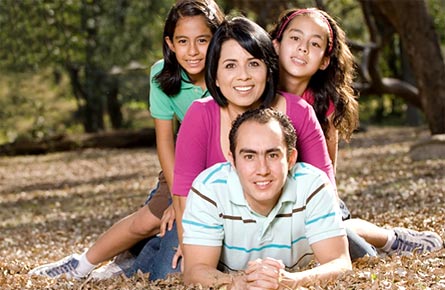Traits of Healthy Families

A Healthy Family:
- Communicates and listens
- Shares table time and conversation – they eat together
- Affirms and supports one another
- Teaches respect for others
- Develops a sense of trust among members
- Has a sense of play and humor
- Has a balance of interaction among members
- Shares leisure time – they do things together
- Exhibits a sense of shared responsibility
- Teaches a sense of right and wrong
- Has a strong sense of family in which rituals and traditions abound
- Has a shared religious core
- Respects the privacy of one another
- Values service to others
- Admits and seeks help with problems
COMMUNICATES AND LISTENS
1. Exhibits an unusual relationship between the parents; shared power – democratic principals at work.
2. Has control over television; communication and interaction have higher priority
than television.
3. Practices active listening and responds.
4. Recognizes nonverbal messages.
5. Encourages individual feelings and independent thinking.
6. Recognizes turn-off words and put-down phrases.
7. Interrupts, but equally.
8. Develops a pattern of reconciliation.
VALUES TABLE TIME AND CONVERSATION. AFFIRMING AND SUPPORTING
1. Parents have good self esteem, share a sense of purpose, and recognize the need to
actively build self esteem in their children.
2. Expected to affirm and support.
3. Realizes support doesn’t mean pressure.
4. Basic mood is positive.
5. Supports its institutions, but not automatically.
TEACHES RESPECT FOR OTHERS
1. Respects individual differences within the family.
2. Knows that self-respect means just that – respect for self.
3. Affords respect to all groups, not just specifically approved ones.
4. Respects individual decisions.
5. Shows respect to those outside the family.
6. Respects the property of others.
DEVELOPS A SENSE OF TRUST
1. Husband and wife trust each other deeply.
2. Children are gradually given more opportunity to earn trust.
3. Don’t play the trust-trap game.
4. Doesn’t break trust for the amusement of others.
5. Realizes broken trust can be mended.
6. Parents as well as children are trustworthy.
HAS A SENSE OF PLAY AND HUMOR, HAS A BALANCE OF INTERACTION AMONG MEMBERS, SHARES LEISURE TIME
1. Pays heed to its need to play.
2. Recognizes its stress level.
3. Doesn’t equate play with spending money.
4. Uses humor positively.
5. Does not allow work and other activities to infringe routinely upon family time.
6. Actively discourages the formation of coalitions and cliques within the family.
7. Keeps its collective leisure time in balance.
8. Prioritizes its activities.
9. Prizes opportunities to spend time alone with individual members.
10. Controls television usage.
11. Plans how to use its time.
EXHIBITS A SENSE OF SHARED RESPONSIBILITY
1. Understands the relationship between responsibility and self-esteem.
2. Understands responsibility means more than doing chores.
3. Realizes that responsibility doesn’t necessarily mean orderliness and perfection.
4. Gears responsibility to capability.
5. Responsibility is paired with recognition.
6. Expects members to live with the consequences of irresponsibility.
TEACHES A SENSE OF RIGHT AND WRONG
1. Husband and wife share a consensus of important values.
2. The parents teach clear and specific guidelines about right and wrong.
3. Children are held responsible for their own moral behavior.
4. The family realizes intent is crucial in judging behavior.
5. Parents help children live morally.
HAS A STRONG SENSE OF FAMILY IN WHICH RITUALS AND TRADITIONS ABOUND
1. Treasures its legends and characters.
2. Has a person and/or a place that serves as locus.
3. Makes a conscious effort to gather as a people.
4. Views itself as a link between the past and the future.
5. Honors its elders and welcomes babies.
6. Cherishes its traditions and rituals.
HAS A SHARED RELIGIOUS CORE
1. Faith in God plays a foundational role in daily family life.
2. A religious core strengthens the family support system.
3. The parents feel a strong responsibility for passing on the faith, but they do so in positive and meaningful ways.
RESPECTS THE PRIVACY OF ONE ANOTHER
1. Looks forward to the teen and separating years.
2. Moves from a base of parental rules to one of mutually negotiated rules.
3. Does not dole out respect according to age, sex, or any other criterion.
4. Respects fads, friends, confidences, room privacy, and time to be alone.
5. Lets go.
VALUES SERVICE TO OTHERS
1. Basically empathetic and altruistic.
2. Serves others in concrete ways.
3. Seeks to simplify its life-style.
4. Generously hospitable.
5. Keeps its volunteerism under control.
ADMITS TO AND SEEKS HELP WITH PROBLEMS
1. Expects problems and considers them opportunities for growth.
Do you see your family in the traits above? If in some and not others that’s okay because all of the above traits can be grown and developed within your own family regardless of the family type – nuclear, blended, extended, single parent, etc. In Curran’s book she provides suggestions for building the traits above.
Healthy, strong families are built they just don’t happen. You and your partner are the architects and builders. It’s your opportunity to create all those traits you longed for when you were growing up. Start by getting rid of any behaviors that are not supportive, respectful and loving. Also, every family member needs to understand they have a part in improving the relationships and strengthening the family – it’s not just dad and mom responsibility.
By studying the common traits shared by successful families, you can better understand how to strengthen your own family. By strengthening these areas in your own family, you will improve relationships and increase your chances of a stable home. Our goal should be to leave our children the legacy of a warm loving family where everyone blossoms and becomes the best “family” we could be. As our families improve so will our societies. Order the book by clicking the image below.








